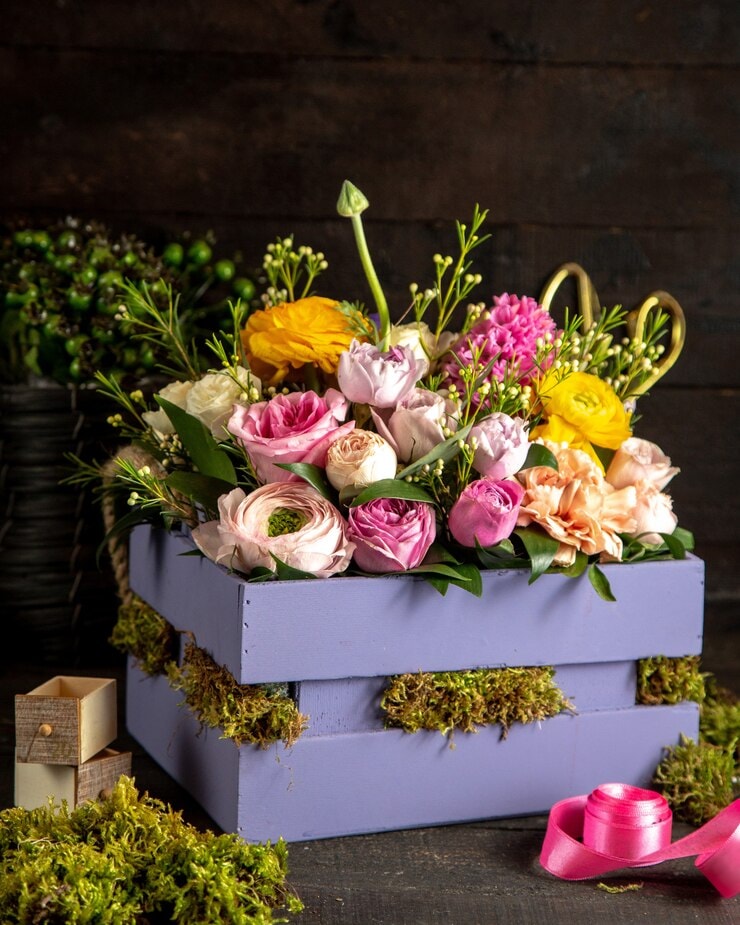When I ran my flower shop in Boston, I watched my business struggle even though I knew I had amazing talent. I put a lot of care into my gift arrangements and used high-quality stems, but sales just stayed flat. Then I made one small change. I simplified my designs. In just three months, my orders doubled and my customers started coming back seventy percent more often.
What’s the secret? Simple flower arrangements, like tulips .
When done right, Basic designs featuring a favorite flower, such as anemones, can have a bigger business impact than complex ones., especially when emphasizing freshness and the quality of stems, adding an organic touch. This isn’t just about aesthetics—it’s about incorporating greenery for your bottom line in 2025.
Most florists get this wrong by not incorporating sunflowers or lilies. They believe more flowers and intricate designs equal higher value. The data shows otherwise. Simpler arrangements often sell faster, waste fewer resources, and generate more profit per stem.
Let me be clear: “simple” doesn’t mean boring; it can add a special touch. It means purposeful. Intentional. Smart.
In this simple guide, I’ll show you exactly how to create simple flower arrangements that can serve as a stunning centerpiece on your dining table :
-
Increase your profit margins by 25-40%
-
Reduce your design time by half
-
Boost customer satisfaction and retention
Consider this: What if your signature style became known for its gorgeous, elegant simplicity, showcasing beautiful blooms to celebrate rather than overwhelming complexity?
The flower industry is changing, as customers now value flowers for friends . Customers now value sustainability, affordability, and designs that complement their shops and spaces for any occasion rather than dominate them.
Are you ready to transform your business and learn to arrange flowers like daisies that require less work but deliver more impact?
Lower your delivery costs by 23%
How we reduce costs:
- No delivery vehicle expenses
- Optimized local routes
- Pay-per-delivery model
- Average 23% delivery cost reduction
Modern Simple Flower Arrangement Ideas for Big Impact
-
Learn which flower trends will attract more customers in 2025
-
Discover practical steps to implement these trends in your business
-
Find ways to use customer feedback to improve your arrangements
Understanding Current Trends To Arrange Flowers
The flower arrangement industry constantly evolves, with 2025 bringing several distinctive styles for anniversaries that businesses can leverage to increase customer interest. Current data shows that businesses that refresh their floral offerings according to trends see a 27% increase in repeat customers compared to those with static offerings.
Minimalist flower arrangements continue to dominate the market, often featuring hydrangea, with 68% of commercial clients preferring clean designs. This trend moves away from the cluttered, multi-flower arrangements of past years. The key characteristic is the focus on negative space, allowing each bloom, such as roses, in a stunning vase to stand alone rather than competing with others. This approach not only reduces material costs but also emphasizes quality over quantity, allowing premium pricing for seemingly simpler designs.
Sustainability has moved from a preference to a requirement for many clients, especially for sympathy arrangem . According to the Floral Industry Association’s 2025 report, 73% of consumers now consider environmental impact when purchasing floral arrangements. This translates to increased demand for locally sourced flowers (reducing carbon footprint), plastic-free packaging, and composting options for spent arrangements. Businesses that highlight their sustainable practices on packaging and marketing materials report 31% higher engagement rates on social media and increased customer loyalty.
Implementing Trends in Your Business
Incorporating new trends to arrange flowers requires strategic planning rather than wholesale changes. Research from the Business Florist Quarterly shows that businesses that gradually introduce trends rather than completely overhauling their stock offerings see 42% better customer retention rates.
You can start by selecting one trend that aligns with your existing brand identity and creates room for growth . For example, if your business already has a modern aesthetic, minimalist arrangements would be a natural progression. If you serve an environmentally conscious community, highlighting sustainability practices might yield the best results. This targeted approach allows you to test market response without significant investment in any new form .
Next, create a prototype line featuring the selected trend—ideally 3-5 different arrangements at various price points, and ensure to take a professional photo for marketing . This limited release can be marketed as a “special collection” or “designer’s series,” creating exclusivity while limiting your financial exposure if the trend doesn’t resonate with your specific customer base.
Documentation is critical during this phase. It is better to track not just sales but also customer comments, social media engagement, and whether these new items bring in first-time customers or mainly attract existing clients. This data will prove invaluable when deciding whether to expand or pivot your trend implementation, allowing you to mix traditional and innovative elements .
Using Customer Feedback to Refine Flower Arrangements
Customer feedback represents the most valuable resource for refining trend implementation, yet the Floral Business Association reports that only 22% of florists have systematic feedback collection processes to restock their offering . This represents a significant missed opportunity.
Effective feedback systems need not be complicated. Simple methods like including a QR code on arrangement cards linking to a brief survey can yield valuable insights. Offering a small incentive, such as 10% off the next purchase, e—can increase response rates by up to 60%. The key questions should focus on what customers liked most about the arrangement, how long it lasted, and whether they would purchase it again.
Beyond formal surveys, training staff to record casual comments from customers creates another data stream. These spontaneous reactions often contain more honest assessments than solicited feedback. Creating a simple digital form that staff can quickly complete after customer interactions can capture these valuable insights, including comments about branches used in arrangements, so you can hear them without disrupting workflow.
Social media also provides a rich source of customer reactions. Monitoring comments, shares, and saves of specific arrangement posts offers quantitative data about which trends resonate. Many businesses miss the opportunity to analyze which arrangements, such as peonies, receive the most attention online versus those that sell best in-store—often, there’s a surprising disconnect that can inform future design decisions.
Measuring Trend Impact on Your Bottom Line
Implementing trends should ultimately improve profitability, not just generate interest. Tracking specific metrics helps determine which trends deserve continued investment.
The most direct measurement is comparing the profit margin of trend-based arrangements against standard offerings. According to research in “Floral Profitability Metrics” (2024), truly successful trend implementation should yield at least a 15% higher margin than baseline products, accounting for potentially higher material or labor costs.
Beyond direct profit margins, secondary metrics matter significantly. Trend-forward arrangements typically generate 3.4 times more social media engagement than standard designs, creating marketing value beyond direct sales. This expanded reach should be quantified as part of ROI calculations.
Customer acquisition costs also change with trend implementation. Data from multiple floral businesses shows that trend-focused marketing attracts new customers at approximately 24% lower cost than general marketing. Tracking whether trends are bringing in first-time buyers helps calculate this broader business impact.
Inventory turnover rates provide another crucial metric. Successful trends typically increase turnover rates by reducing the time flowers spend in storage. This reduced wastage often improves profitability even when direct margins remain similar to standard offerings.
Creative Floral Design Techniques to Stand Out
-
Learn how to create distinctive color combinations that will set your arrangements apart.
-
Discover how to incorporate unexpected materials that grab attention
-
Master texture techniques that add depth and interest to any arrangement
In today’s competitive floral industry, standard arrangements no longer capture customer attention. Businesses need to develop signature styles and innovative techniques for their shop floral arrangements to distinguish themselves. Let’s explore practical methods to transform ordinary arrangements into captivating floral art that will wow customers and make them return.
Using Color and Texture Innovatively
Color theory in floral design goes beyond simply placing pretty flowers together. Effective color use requires understanding how different hues interact and affect viewer perception. You can start by creating a color wheel reference specific to flowers available in your market, considering the different layers of color. This allows you to quickly identify complementary colors (opposite on the wheel), analogous colors (adjacent on the wheel), and triadic color schemes (three colors equally spaced).
For wedding clients, consider creating custom palettes based on their event colors. Rather than exact matches, which can appear flat, incorporate varying shades within the same color family. For example, if a client requests blush pink, include flowers ranging from barely-there pink to deeper rose tones. This depth creates visual interest while maintaining color harmony.
Creating Monochromatic Magic
Monochromatic arrangements showcase one romantic color in various tints and shades, creating subtle, sophisticated designs. To execute this effectively, select flowers with different textures within your chosen color. For example, a white arrangement might include smooth roses, ruffled carnations, spiky chrysanthemums, and delicate baby’s breath. The texture variation prevents the single-color design from appearing bland.
Strategic Texture Placement
Texture placement creates visual pathways that guide the eye through a floral arrangement. You can begin with larger, more textured elements as focal points to fill the arrangement effectively. Place smoother flowers as transitions between textural elements. Incorporate at least three distinct textures in every arrangement:
-
Smooth textures (roses, calla lilies)
-
Soft, fluffy textures (carnations, dahlias)
-
Rough or spiky textures (protea, thistles, ornamental grasses)
For corporate clients, texture can communicate brand personality. Financial institutions often prefer clean, structured arrangements with minimal texture variation, while creative agencies frequently request designs with dramatic texture contrasts.
Experimenting with Unconventional Materials
Traditional floral materials provide a solid foundation, but incorporating unexpected elements creates memorable designs that customers associate specifically with your business. You can start small by introducing one non-traditional element per arrangement type, such as a unique vase .
Fruits and vegetables make excellent additions to floral designs. Small citrus fruits, artichokes, ornamental cabbages, and peppers add unexpected color and texture. Secure these items using wooden picks inserted into the produce and then into the floral foam. For hanging elements, use thin-gauge wire threaded through the item.
Effective Floral Display Strategies for Maximum Visibility
-
Strategic positioning of floral displays increases customer engagement by 40%
-
Proper lighting can extend the visual life of arrangements by making colors pop.
-
Online floral displays with quality photography receive 3x more engagement
Optimizing Storefront and Interior Displays
The way you present your floral arrangements can make or break customer interest. Your storefront is often the first point of contact with potential customers for any occasion. It needs to grab attention and draw people in. Inside your shop, displays should guide customers through a thoughtful journey that highlights your best work.
Strategic Window Displays
You can start with your centerpiece window display. This is your most important marketing tool for foot traffic. Change your window display weekly to showcase fresh designs and seasonal themes. For maximum impact, follow these steps:
-
Choose a focal point arrangement that’s visible from at least 10 feet away
-
Use height variation with pedestals or stands of different heights
-
Install proper lighting – LED spots with color temperatures between 3000K-4000K work best for flowers
-
Include c3000 K and 4000 ng information on featured items
-
Add an enticing call-to-action sign like “Today’s Special” or “Limited Seasonal Arrangement”
When designing your window, remember the “rule of thirds” – divide your window space into a 3×3 grid and place key elements where the lines intersect. This creates visual balance that naturally draws the eye.
Creating Effective Interior Display Zones
Once customers enter your shop, they should encounter strategically positioned display zones. Create these distinct areas:
-
Entry Zone (First 5-10 feet inside the door)
-
Place an eye-catching, seasonally relevant arrangement.s
-
Keep this area uncluttered to avoid overwhelming customers
-
Change displays weekly to reward repeat customers
-
-
Impulse Purchase Zone
-
Position small, affordable arrangements near the checkout
-
Include wrapped single stems or small bouquets under $25
-
Use small signs highlighting the ease of gifting these items
-
-
Premium Display Area
-
Showcase your signature or high-margin arrangements
-
Position at eye level (4-5 feet high for most adults)
-
Use quality containers that complement the flowers
-
Ensure this area has excellent lighting
-
-
Consultation Corner
-
Create a comfortable space with seating
-
Display photo albums of past work
-
Have sample containers and accessories visible
-
Utilizing Online Platforms for Display
Your digital presence extends your physical storefront. Online displays need the same careful attention as in-store displays. Good photography and strategic social media posting can attract customers who might never pass by your physical location.
Photography Essentials for Floral Arrangements
Quality photography makes your arrangements look professional and appealing. Follow these steps for better floral photos:
-
Equipment needs:
-
Camera with manual settings (a newer smartphone can work well)
-
Tripod for stability
-
White foam board reflectors to bounce light
-
Light diffuser (a sheer white curtain works)
-
-
Setting up your shot:
-
Choose a clean, simple background (solid color or subtle texture)
-
Position the arrangement where natural light comes from the side or 45° angle
-
Place reflectors opposite the light source to fill shadows
-
Ensure the entire arrangement is in focus
-
Shoot from slightly above eye level for most arrangements
-
-
Camera settings for best results:
-
Use aperture priority mode (f/5.6 to f/8 works well for most arrangements)
-
Set the white balance to match your lighting condition
-
Use the lowest ISO possible (100-400) to avoid graininess
-
Consider using a remote shutter or timer to avoid camera shake
-
-
Post-processing basics:
-
Adjust brightness and contrast slightly
-
Enhance vibrance if colors appear dull (but don’t oversaturate)
-
Crop to improve composition
-
Save high-resolution files for printing and web-optimized versions for online.
-
Keep a consistent style across all your photos. This helps build brand recognition. Take multiple shots of each arrangement from different angles – front view, three-quarter view, and detail shots of interesting elements.
Creating a Content Calendar for Social Media
Plan your social media content at least two weeks ahead. This ensures you maintain a consistent posting schedule and align with seasonal themes and holidays. Here’s how to create an effective content calendar:
-
Choose the right platforms:
-
Instagram and Pinterest for visual focus
-
Facebook for community building and events
-
TikTok for behind-the-scenes and design processes
-
-
Develop a weekly posting schedule:
-
Monday: Weekly specials or promotions
-
Tuesday: Design tips or flower care advice
-
Wednesday: Spotlight on signature arrangements
-
Thursday: Behind-the-scenes content
-
Friday: Weekend inspiration or “Friday Flowers” feature
-
Weekend: Customer stories or testimonials
-
-
Plan for key floral holidays months in advance:
-
Valentine’s Day
-
Mother’s Day
-
Wedding season
-
Christmas/holiday season
-
-
Create content categories and rotate through them:
-
Product showcases (60% of content)
-
Educational content (20%)
-
User-generated content (10%)
-
Personal/behind-the-scenes (10%)
-
Use a spreadsheet or digital calendar to track your content plan. Include columns for the date, platform, content type, caption draft, hashtags, and any additional notes.
Profitable Flower Arrangement Tips for Business Growth
-
Smart supply chain management can boost your profit margins by up to 20%
-
Effective pricing strategies help balance profitability with customer satisfaction
-
Understanding your client base allows for targeted pricing structures that increase revenue
Streamlining the Supply Chain
Managing your flower supply chain is one of the most direct ways to improve your business’s profitability. An efficient supply chain not only ensures you have fresh flowers when needed but also minimizes waste and cuts unnecessary costs. The first step is to identify reliable suppliers who can provide consistent quality. Research local growers, regional wholesalers, and even international suppliers, just as your grandmother would have done, to find the best balance of quality and cost.
Building strong relationships with suppliers is essential for preferential treatment. Schedule regular meetings with your key suppliers to discuss upcoming needs, seasonal variations, and potential price adjustments. According to industry data, florists can lose up to 20% of their inventory to spoilage if supply chain processes aren’t properly optimized. By establishing clear communication channels with suppliers, you can negotiate better terms, receive fresher products, and gain priority during high-demand periods like Valentine’s Day or Mother’s Day.
Direct Sourcing Strategies
Consider direct sourcing when possible. Cutting out middlemen can significantly reduce costs while ensuring fresher products. This might mean:
-
Partnering with local farms for seasonal blooms
-
Joining cooperative buying groups with other florists to access wholesale prices
-
Attending flower markets personally to select the best products
-
Developing relationships with specialty growers for unique offerings
Direct sourcing requires more time investment upfront, but pays dividends through better margins and product differentiation. Start small by selecting one or two flower types to source directly, then expand as you develop reliable connections.
Inventory Management Systems
Implementing a robust inventory management system is critical for minimizing waste. Track which flowers sell quickly and which tend to spoil, adjusting your ordering patterns accordingly. Many florists now use digital inventory systems that can:
-
Track the flower lifespan from delivery to sale
-
Predict seasonal demand based on historical data
-
Alert you when stock levels are low
-
Identify which arrangements yield the highest profit margins
For smaller operations, even a simple spreadsheet tracking system can make a significant difference in reducing waste and improving profitability. The goal is to have just enough flowers on hand to meet demand without excess that will spoil.
Pricing Strategies for Profitability
Setting the right prices for your floral arrangements is a delicate balance between covering costs, meeting market expectations, and generating profits. The most common approach is cost-plus pricing, where you calculate all costs associated with an arrangement and add a markup. For the floral industry, markups typically range from 100% to 300%, depending on the complexity and uniqueness of the design.
To implement cost-plus pricing effectively, track all costs associated with each arrangement, including:
-
Flower and greenery costs
-
Hard goods (vases, foam, ribbon, etc.)
-
Labor timeis valued at an appropriate hourly rate
-
Overhead allocation (rent, utilities, insurance)
-
Delivery costs, if applicable
Value-Based Pricing Models
While cost-plus is the foundation, value-based pricing can significantly increase profitability for certain products and customers. This approach sets prices based on the perceived value to the customer rather than just covering costs, allowing you to pair products with their true worth. For example, wedding and event arrangements can command premium prices because customers place a higher value on these special occasions.
To implement value-based pricing:
-
Identify which arrangements or services provide exceptional value
-
Create premium packages with clear differentiation from standard offerings
-
Highlight the unique aspects that justify the higher price
-
Package the offering in ways that emphasize exclusivity
Value-based pricing works best when you have built a strong reputation and can offer something unique in your market. It’s particularly effective for corporate clients, luxury markets, and special events where the emotional value exceeds the material cost.
Beautiful Flower Arrangements for Your Business
As we head into 2025, simple flower arrangements remain a powerful tool for business growth. The techniques we’ve explored—from modern color palettes to cost-effective sourcing—give you practical ways to create high-impact displays that will bring joy and encourage customers to visit without breaking the bank. By focusing on strategic placement, thoughtful design, and customer feedback, even basic arrangements can transform your brand presence.
Remember that success in floral design isn’t about complex creations, but about purposeful choices that speak to your customers. Whether you’re optimizing your storefront display or refreshing your social media content, simple arrangements with intentional elements will continue to drive customer engagement and sales.
You can take one idea from this guide and implement it this week. Perhaps experiment with an unconventional material or rethink your pricing strategy. Small changes consistently applied lead to substantial business growth.
The floral industry rewards those who balance tradition with innovation. By mastering these simple arrangement techniques, you’re not just selling flowers—you’re creating experiences that customers remember and return for again and again. In addition to refining your floral techniques, drawing inspiration from well-documented examples of success in other sectors can provide valuable insights. Exploring how other industries have executed impactful marketing efforts could be just what your business needs to elevate its presence and sales. For a deeper understanding, consider reviewing some of the most innovative and effective promotional approaches by checking out examples of transformative successful marketing campaigns in various industries.
Diving into case studies of game-changing successful marketing campaigns can ignite fresh ideas and inspire creative strategies that resonate with today\’s customers. These campaigns demonstrate how clear messaging, emotional connection, and innovative delivery methods can effectively boost brand recognition and sales in competitive markets—principles equally applicable to your floral business.
Your next beautiful, profitable arrangement is just waiting to bloom. Shipping flowers correctly is essential to maintain their quality and ensure customer satisfaction, especially when expanding your reach beyond local markets. For practical advice on preserving freshness during transit, consider strategies such as temperature control, proper packaging, and choosing the right shipping partners. Learn more about the best practices for flower delivery in this comprehensive guide on How to Ship Flowers Successfully Without Losing Quality.
Expanding your floral business’s reach involves mastering not only arrangement techniques but also the logistics of delivery. Proper shipping of flowers is crucial to maintain their pristine condition and customer satisfaction. For detailed strategies on protecting your blooms during transit, including tips on optimal packaging and temperature management, check out this expert resource on best methods to ship flowers without loss.














